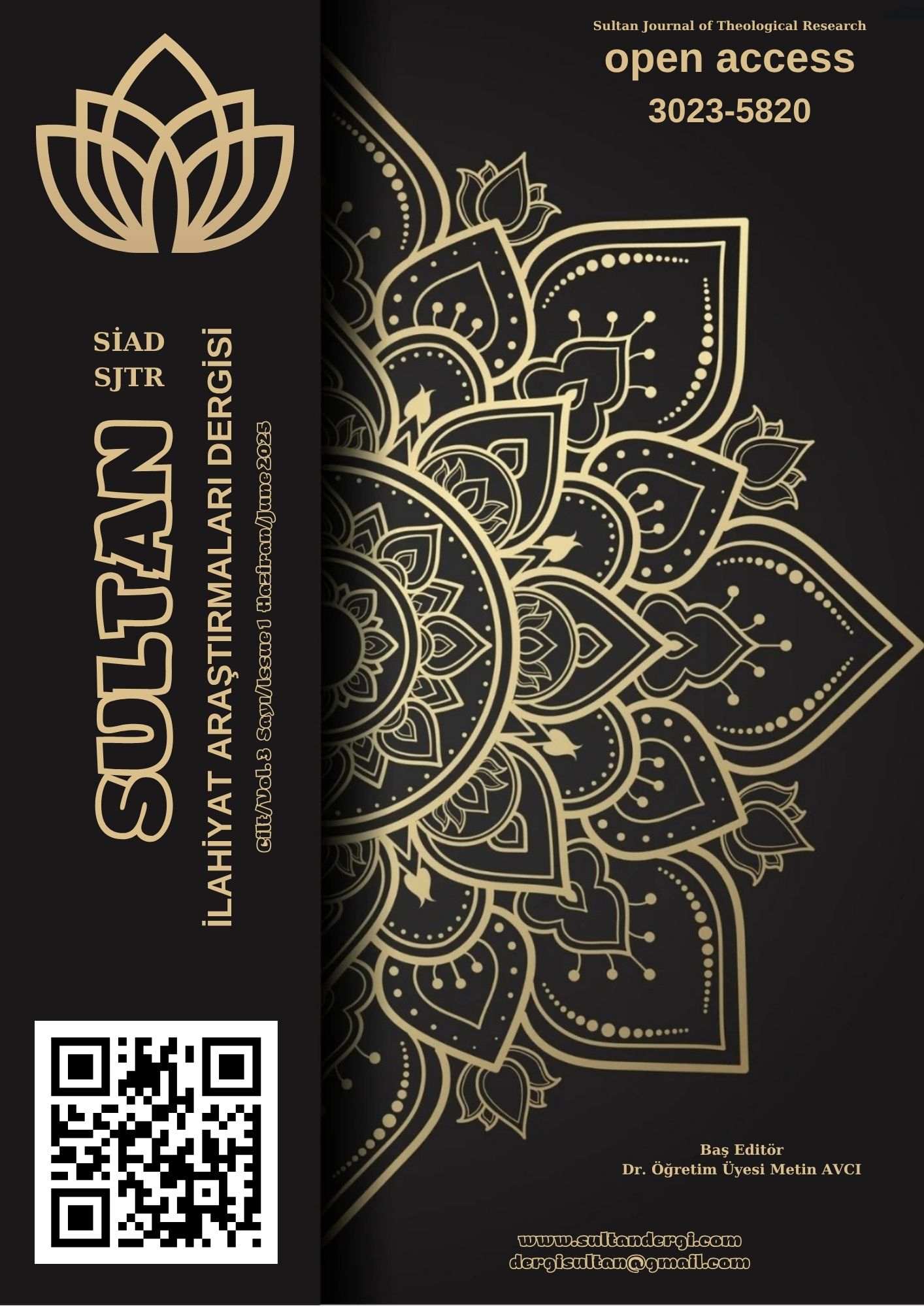The Problem of Overpraise in the Hadith Tradition: A Case Study of Two Widely Circulated Narrations about Aisha
DOI:
https://doi.org/10.5281/zenodo.15778043Keywords:
Hadith, Fabricated Hadith, Criticism, Idealization, Aisha.Abstract
This study examines some narrations about Aisha (RA) that include too much praise and are often linked to the Prophet Muhammad (PBUH). These narrations are shared today in books, websites, and social media. The aim is to check these narrations using traditional hadith science rules to see if they are reliable. First, main hadith books were studied. Then, the study looked for the first sources where these narrations appeared. After that, each narration was checked by looking at its chain of narrators (isnad) and the meaning of the text (matn). The results show that most of these reports have weak or broken chains, and their messages do not match the Qur'an or the correct Sunnah. The study also shows that many of these stories may come from political, sectarian, or emotional reasons, not from true Islamic teachings. To help show the difference, the study also includes real and trusted hadiths about Aisha (RA). In this way, the study reminds readers to be careful when they see popular religious sayings that may not be true.
Highlights
- The study approaches hadiths from a critical perspective
- The chains of transmission (isnads) of the hadiths are examined.
- The research emphasizes the need for caution when forming religious discourse.
- The study highlights Aisha’s role as a critical scholar in Islamic tradition
- Classical sources are analyzed using traditional hadith criticism methods.
References
Buhârî, Ebû Abdullah Muhammed b. İsmâil b. İbrâhîm el-Cuʿfî. el-Câmiʿu’s-sahîh. thk. Muhammed Züheyr b. Nâsır en-Nâsır. I-IX Cilt. yy: Dâru Tavku’n-Necât, 1. Basım, 1422.
Ebû Nuaym, Ahmed b. Abdillah el-İsfehânî. Hilyetü’l-evliyâʾ ve tabakâtü’l-asfiyâʾ. I-X Cilt. Kahire: Matbaatü’s-Saade, 1974.
Ebu’l-Kâsım Temmâm b. Muhammed el-Becelî er-Râzî. el-Fevâid. II Cilt. Riyâd: Mektebetü’r-Ruşd, 1. Basım, 1991.
Ebü’l-Hasen Nûrüddîn Alî b. Sultân Muhammed el-Kārî el-Herevî. el-Esrârü’l-merfû‘a fi’l-ehbâri’l-mevzû‘a. thk. Muhammed es-Sibâğ. Beyrut: Dârü’l-Emâne, ty.
Eren, Mehmet. “Ricâl Kitaplarında Mükerrer ve Uydurma Biyografi Problemi”. Selçuk Üniversitesi İlahiyat Fakültesi Dergisi 16 (2003), 51-72. https://dergipark.org.tr/tr/download/article-file/184420
Erul, Bünyamin. “Hadiste Eleştirel Yaklaşımın Öncüsü Olarak Hz. Âişe”. İslâmiyât 3/2 (2000), 109-129.
Gül, Recep Emin. “Merdûd Bir Rivayetin Sanal Alemdeki Serencâmı: Hz. Peygamber’in Hz. Meryem ile Evleneceğine Dair Rivayetin Tahrîc ve Tahlîli = The Consequence of a Rejected Narration in the Virtual World: Establishment (Takhrij) and Analysis (Tahlil) of the Narration About the Prophet’s Marriage to Mary”. Yüzüncü Yıl Üniversitesi Sosyal Bilimler Enstitüsü Dergisi = Journal of Social Sciences 63 (2024), 173-183.
Hatiboğlu, Mehmed S. “Hazret-i Âişe’nin Hadis Tenkidciliği”. Ankara Üniversitesi İlahiyat Fakültesi Dergisi 19 (1973), 59-74.
Hatice Kübra Tongar (@haticekubratongar). “Kördüğüm Gibi Yazılı Yüzük Tanıtımı”. Instagram. Erişim 10 Mayıs 2025. https://www.instagram.com/p/CSXRL40KXBV.
İbn Arrâk, Ebü’l-Hasen Nûruddîn. Tenzîhü’ş-şerîati’l-merfû’a ’ani’l-ahbâri’ş-şenî’ati’l-mevzû’a. thk. Abdülvehhâb Abdüllatîf, Abdullah Muhammed es-Sıddîk. I-II Cilt. Beyrut: Darü’l-Kütübi’l-İlmiyye, 2. Basım, 1981.
İbn Hacer el-Askalânî, Ahmed b. Ali. Lisânü’l-Mîzân. thk. Abdülfettah Ebû Gudde. I-X Cilt. Beyrut: Mektebü’l-Matbuati’l-İslâmiyye, 1. Basım, 2002.
İbn Kayyim el-Cevziyye. el-Menâru’l-münîf fi’s-sahîhi ve’d-daîf. thk. Abdülfettah Ebû Gudde. Haleb: Mektebetü’l-Matbûâti’l-İslâmiyye, 1. Basım, 1970.
İbn Kesîr, Ebü’l-Fida İmamüddin İsmail b. Ömer. el-Bidâye ve’n-nihâye. thk. Abdullah b. Abdülmuhsin et-Türki. I-XXI Cilt. yy: Daru Hicr, 1. Basım, 1997.
İbnü’l-Cevzî, Ebü’l-Ferec. Kitâbü’l-mevzûʿât. thk. Abdurrahman Muhammed Osman. I-III Cilt. Medine: el-Mektebetü’s-Selefiyye, 1. Basım, 1968.
Keskin, Yusuf Ziya. “Mevzu Hadis Literatüründe Hz. Ali”. Hazreti Ali. ed. Ali Aksu. 327–374. Sivas: Sivas Cumhuriyet Üniversitesi Rektörlük Matbaası, 2020.
Kotan, Sehal Deniz. “Hz. Peygamber Hanesinde Yetişmiş Bir Kadın: Aişe Validemiz”. Kutlu Doğum Haftası “Hz. Peygamber ve İnsan Yetiştirme Düzenimiz” Sempozyumu. 341-355. Erzurum: Diyanet İşleri Başkanlığı, 2015.
Okumuş, Zehra Şener. Hadislere Göre En Faziletli Kadın ve Özellikleri. İstanbul: İstanbul Üniversitesi, Sosyal Bilimler Enstitüsü, Yüksek Lisans Tezi, 2019.
Özçelik, Fikret. “Hadis Tenkidinde Sahâbe Modeli: Hz. Âişe Örneği”. Uluslararası İslâm ve Model İnsan Sempozyumu = International Symposium on Islam and Model Human. Kahramanmaraş: 2018, 2/319-327.
Siyer Dergisi. Nebevî Şuurdan Medeniyet İnşasına, “Humeyranın dilinden”, Erişim 10 Mayıs 2025. https://www.siyerdergisi.com/humeyranin-dilinden/
Şîrûye b. Şehredâr ed-Deylemî. el-Firdevs bi me’sûri’l-hitâb. thk. es-Saîd b. Besyûnî Zeğlûl. V Cilt. Beyrut: Darü’l-Kütübi’l-İlmiyye, 1. Basım, 1986.
Takıda Sanat. “Kördüğüm Gibi Yazılı Gümüş Taşlı Bayan Yüzük”. Erişim 15 Mayıs 2025. https://www.takidasanat.com/kordugum-gibi-yazili-tasli-gumus-bayan-yuzuk
Zehebî, Şemseddin Muhammed b. Ahmed. Mîzânü’l-iʿtidâl fî nakdi’r-ricâl. thk. Ali Muhammed Bicavi. I-IV Cilt. Beyrut: Dârü’l-Ma’rife, 1. Basım, 1963.
Downloads
Published
How to Cite
Issue
Section
License
Copyright (c) 2025 Ebru Adıyaman

This work is licensed under a Creative Commons Attribution-NonCommercial 4.0 International License.





